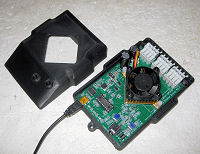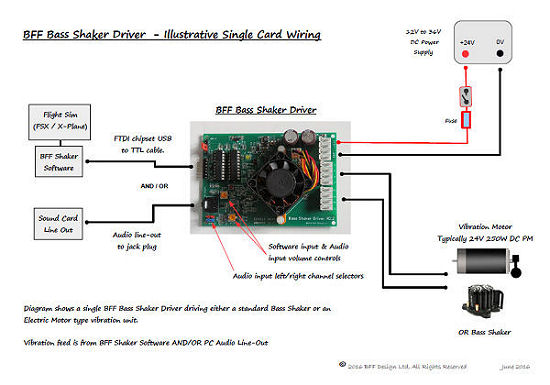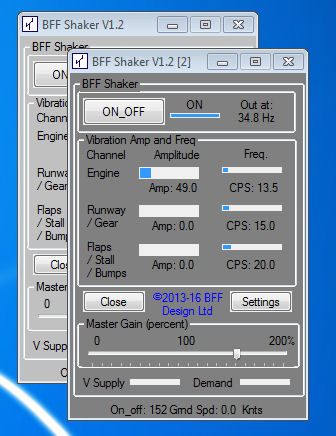Bass Shaker Driver V2 card for Simulators
(and for general Audio Systems)
UPDATE - JUNE 18 - V2 of the BSH-DRV card
is now available and is supported by V1.5 of the BFF Shaker
Software.
The BFF BSH-DRV-2 Bass Shaker Driver is a direct
driver card for Bass Shakers.
V2 of the card adds:
-
Direct USB connection (no COM port
settings)
-
Faster controller giving 1000Hz wave
construction for better wave definitions with new
sub-wave strength settings.
-
V1.5 Shaker software with new Wave Tester
window, individual gear touch-down thumps, individual
gear housing thuds, multi-engine start/stop shudders,
engine resonance behaviours.
-
Optional 3D printed casing.
It can drive both conventional bass shakers
(such as Buttkickers), and DIY electric motor based vibration
transducers - without additional amplifier or motor driver hardware.
It is a standalone card and requires a separate 12V to 36V DC power
supply - see below.
DRIVER FEATURES
-
Robust and easy to use.
-
Can drive both conventional bass shakers
and electric motor based vibration units directly.
-
Can drive multiple shakers in
combination. Provides flexibility for pit builders to
experiment. Can drive loads down to 0.75 Ohm resistance
so allows for connection of multiple bass shakers wired
in parallel, or single electric motor type shakers.
-
Dual vibration input sources:
1. Real physics flight sim vibration feed for FSX &
X-Plane using the BFF Shaker Software.
2. General audio feed (sound card line out etc) for all
games and other audio sources.
-
Vibration input sources can be used
individually or in combination in same card - to enhance
vibration response across the frequency range (with
single combined output).
-
Separate on-board volume controls for
each input feed - to allow optimised mixing of the dual
input sources.
-
Over-current, over-temperature and load
short-circuit protection - employs robust advanced
electric motor driver technology.
-
On-board clipping indicator - to set
input source volume for maximum non-distorted output
signal.
-
Option to use two cards in stereo mode;
left/right audio input channel is selectable on-board.
-
V2 card - Direct USB connection (no COM
ports) and vibration wave construction in 1ms steps
(1000Hz).
|

BFF
Bass Shaker Driver
V2 with optional 3D printed case
(Note supplied
cover is BLUE - not black as shown in image)
Technical Data
Sheet |
TECHNICAL DETAILS
-
Input Voltage Range: 12V to 36V DC (do
not exceed 36V)
-
Non-clipped power output at 4 Ohm load:
12V supply: 27W peak, 14W rms
24V supply: 109W peak, 55W rms
36V supply: 245W peak, 122W rms
(Power values roughly double for 2 Ohm loads)
-
Minimum load resistance: 0.75 Ohm
-
Typical max current draw: 6 Amp rms, can
be as high as 12 Amp peak with very low resistance loads
driven hard
-
Software Input - Frequency Range (3 dB
bandwidth): 0.5 to 50 Hz
-
Audio Input - Frequency Range (3 dB
bandwidth): 2 to 88 Hz
-
Audio Input - Sensitivity: 500mV pp (180mV rms). Sensitivity can be controlled using on-board volume
pot.
TYPICAL
SYSTEM CONFIGURATION

Typically the Bass Shaker Driver would be
used to drive a single Bass Shaker or an Electric Motor
vibration unit. However more than one shaker can be
connected to a single card to provide a more distributed
vibration output in a sim pit. The vibration feed would be from the BFF
Shaker Software for flight sims, and/or from a PC audio
line-out for other sims or from other audio sources.
|

Testing with a
ButtKicker Advance and 36V PSU |
In the case of FSX or X-Plane flight sims the
two vibration feeds can be used together. The card has
on-board volume controls for each feed so allowing optimised
mixing of the inputs. The allows the vibration output to
take advantage of the strengths of each source to give more
complete coverage across the frequency range.
The output current capacity of the card
allows loads as low as 0.75 Ohms to be connected. This makes
it
possible to connect more than one bass shaker wired in
parallel. The vibration feed to each shaker will be the same
in this configuration and can provide a more uniform
distribution of vibration across a structure.
Dual cards can be used in a two "stereo"
channel arrangement - see the image below: the cards have
on-board left/right input selectors for the audio
feed. Additionally the BFF Shaker software (V1.2+) can be
run in dual-instance mode (two copies at once) and can
therefore drive each card in a dual setup with different
vibration tuning but from the same flight sim source.

Power Supplies
The range of bass shakers and electric motor vibration
transducers that the card can drive is wide, and so the
power supply requirements can vary considerably from setup
to setup. If you are only driving single small/medium sized
bass shakers then fitting a full size PSU may be
unnecessary, driving low resistance electric motor type
shakers may need more current at normal voltage, whereas
driving larger higher resistance shakers may need more
voltage to generate the output current and so power
required..
The following are suggestions for PSU’s..
Meanwell make a range of suitable PSU's, you may still be
able to find older models on Ebay etc
Meanwell NES-150-24:
(Alternative
HRP-150-24)
This is a 24V 6.5Amp PSU suitable for driving single or
small numbers of the smaller to medium sized Buttkicker
units or similar sized bass shakers.
Meanwell NES-200-24:
(Alternative
HRPG-200-24)
A 24V 8.8Amp supply which will give a bit more current
capacity for driving single lower resistance electric motor
based vibration transducers.
Meanwell NES-200-36:
(Alternative
HRPG-200-36)
This is a 36V 5.9Amp supply. The higher 36V voltage will
allow bigger power outputs to be generated for larger 4 Ohm
(or higher resistance) transducers.
Meanwell NES-350-36:
(Alternative
HRP-300-36)
This is a 36V 9.7Amp supply which should be able to cover
most of the power requirements for the BSH-DRV-1 card in a
range of set-ups. Overkill for smaller systems though.
SOFTWARE
For more information on the software see the
on-line user guide.
The existing BFF Shaker software is being upgraded for the
new card, and I hope to look at providing racing sim
versions of the software in addition to the current flight
sim version.
The BFF Shaker software drives the vibration
output of the system. It extracts live flight data from MSFS
or X-Plane and calculates the vibration amplitudes,
frequencies and mixes to send to the Bass Shaker Driver card. The
vibration outputs change as the flight state changes.
 It
is important to note that the vibration output is not
derived from the audio output of the flight sim as it is in
conventional rumble units. Each vibration component (engine,
runway, bumps, shudders etc) is calculated by the software
in response to live flight conditions and events. This
allows better definition of individual vibration effects and
greater control of the relative strengths of the effects.
It
is important to note that the vibration output is not
derived from the audio output of the flight sim as it is in
conventional rumble units. Each vibration component (engine,
runway, bumps, shudders etc) is calculated by the software
in response to live flight conditions and events. This
allows better definition of individual vibration effects and
greater control of the relative strengths of the effects.
The tuning for the vibrations is set using
the software (click image below for details). Typically each
continuous effect (eg engine running vibrations, runway
rolling vibrations etc) has a basic gain (strength) and
frequency setting. Additional settings provide control over
the mix of waves used for each effect, randomisation of
frequencies etc, Where appropriate, settings for max and min
levels and scaling effects are provided. In addition
settings are provided for one-off or repeated discrete
events such as touch-down bumps, engine start/stop shudders,
semi-random runway bumps etc.
The settings are saved in .cfg files so your
setup for particular aircraft models or types of aircraft
can be kept separate.
Pop-up help tips are provided in the software
which can be used to learn more about a specific setting.
V1.2 or later of the Shaker software can be
run two copies at once - this allows two vibration feeds
that can be used to drive separate Shaker Driver cards but
with different vibration settings.
V1.4d adds a beta feature for Air Turbulence
effects.
V1.5 adds support for the BSH-DRV-2 card
including new wave definition parameters and new vibration
testing features.. It also adds individual gear housing
thumps and touch-down thumps, support for up to 4 engine
start/stop thumps and engine vibration resonance effects.
The software can be used free of charge for
personal, non-commercial projects. For use in commercial
projects please contact me.
© This site is
copyrighted, If you'd like more information or have any
comments please contact me at